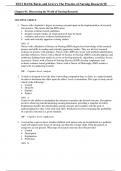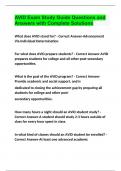TEST BANK Burns and Grove's The Practice of Nursing Research 9E
Chapter 01: Discovering the World of Nursing Research
MULTIPLE CHOICE
1. Nurses with a bachelor’s degree in nursing can participate in the implementation of research
into practice. This means that the BSN nurse:
a. develops evidence-based guidelines.
b. designs research studies on which protocols may be based.
c. evaluates and revises evidence-based protocols.
d. reads and critically appraises existing studies.
ANS: D
Nurses with a Bachelor of Science in Nursing (BSN) degree have knowledge of the research
process and skills in reading and critically appraising studies. They use the best research
evidence in practice with guidance. Nurses with a BSN also assist with problem identification
and data collection. Nurses with a Master of Science in Nursing (MSN) critically appraise and
synthesize findings from studies to revise or develop protocols, algorithms, or policies for use
in practice. Nurses with a Doctor of Nursing Practice (DNP) develop, implement, and
evaluate evidence-based guidelines. Nurses with a Doctor of Philosophy (PhD) assume a
major role in conducting research.
DIF: Cognitive Level: Analysis
2. A study is designed to test the idea of providing companion dogs to elders in a major hospital,
in order to determine the effect upon the elders’ level of orientation. This type of study can do
which of the following?
a. Control
b. Describe
c. Explain
d. Predict
ANS: A
Control is the ability to manipulate the situation to produce the desired outcome. Description
involves observing and documenting nursing phenomena, providing a snapshot of reality.
Explanation clarifies the relationships among concepts and variables with the goal of
understanding how they work with each other. Prediction involves estimating the probability
of a specific outcome in a given situation.
DIF: Cognitive Level: Application
3. A researcher wants to know whether children with autism who are hospitalized in a pediatric
ward will require more hours of nursing care than the average child, when the parents or
caregivers are not present. What type of research outcome does this provide?
a. Control
b. Description
c. Explanation
d. Prediction
ANS: D
, Prediction involves estimating the probability of a specific outcome in a given situation.
Control is the ability to manipulate the situation to produce the desired outcome. Description
involves observing and documenting nursing phenomena, providing a snapshot of reality.
Explanation clarifies the relationships among concepts and variables with the goal of
understanding how they work with each other.
DIF: Cognitive Level: Application
4. Despite the presence of an intraventricular drain, the intracranial pressure of a patient in
neurological intensive care remains increased. The nurse recalibrates the machine, makes sure
the monitor is on the same level as the drain, checks all connections, and then notifies the
physician, who comes to the unit and inserts a new drain. What type of reasoning or thinking
prompts the nurse to recalibrate, assure proper placement, and check connections?
a. Abstract thinking
b. Concrete thinking
c. Logical reasoning
d. Dialectical reasoning
ANS: C
Logical reasoning is used to dissect components of a situation or conclusion, examine each
carefully, and analyze relationships among the parts. Abstract thinking is oriented toward the
development of an idea without application to, or association with, a particular instance.
Concrete thinking is oriented toward and limited by tangible things or by events that are
observed and experienced in reality. Dialectical reasoning involves looking at situations in a
holistic way.
DIF: Cognitive Level: Application
5. A nurse with considerable clinical expertise develops a policy for managing agitated patients
in the Emergency Department. The resultant policy emanates from:
a. abstract thinking.
b. concrete thinking.
c. operational reasoning.
d. dialectical reasoning.
ANS: A
Abstract thinking is oriented toward the development of an idea without application to, or
association with, a particular instance. Concrete thinking is oriented toward and limited by
tangible things or by events that are observed and experienced in reality. Operational
reasoning is the identification of and discrimination among many alternatives and viewpoints.
Dialectical reasoning involves looking at situations in a holistic way.
DIF: Cognitive Level: Application
6. A nurse with considerable clinical expertise develops a policy for managing agitated patients
in the Emergency Department. The type of reasoning the nurse uses to do this is:
a. problematic reasoning.
b. operational reasoning.
c. collaborative reasoning.
d. inductive reasoning.
, ANS: D
Inductive reasoning involves reasoning that moves from the specific to the general, whereby
particular instances are observed and then combined into a larger whole or general statement.
Problematic reasoning involves: (1) identifying a problem and factors influencing it, (2)
selecting solutions to the problem, and (3) resolving the problem. Operational reasoning
involves the identification of and discrimination among many alternatives and viewpoints.
Collaborative reasoning occurs when individuals with different perspectives “reason together”
to develop a coordinated plan of action.
DIF: Cognitive Level: Synthesis
7. What is the best explanation of the type of intuition that forms a legitimate source of
knowledge in nursing?
a. It is the result of recognizing patterns in a way that allows rapid conclusions.
b. It is based on a gift from the universe and should be honored when it arrives.
c. It is never inaccurate.
d. It is the process of examining and critiquing one’s thoughts.
ANS: A
Intuition is understanding without rationale. Intuition is described as pattern recognition,
seeing similarities and dissimilarities of a situation and seeing the whole in a way that allows
rapid conclusions. Because intuition is a type of knowing that seems to come unbidden, it may
also be described as a guy feeling, hunch, or sixth sense. Intuition cannot be explained
scientifically, therefore many people discount it or are uncomfortable talking about it. Expert
nurses are more likely to experience intuition, especially when they connect with their patients
and are open to their feelings.
DIF: Cognitive Level: Application
8. Why is operational reasoning necessary for research?
a. Abstract concepts are of no use to nursing.
b. Standard interventions are obtained from operational reasoning.
c. It allows the researcher to devise ways to measure the concepts studied.
d. It facilitates the researcher’s rapport with families.
ANS: C
Operational reasoning involves the identification of and discrimination among many
alternatives and viewpoints. It focuses on the process (debating alternatives) rather than on the
resolution. Nurses use operational reasoning to develop realistic, measurable health goals. In
research, operationalizing a treatment or intervention to implement, comparing measurement
methods, and debating the appropriate data analysis techniques to use in a study require
operational thought.
DIF: Cognitive Level: Application
MULTIPLE RESPONSE
1. Realistically, what might be done in a situation in which a nurse does not know the
appropriate way to use a new ultrasonic bladder scanner (a noninvasive, painless procedure)
but has a new order at 2 a.m. to perform a scan? (Select all that apply.)
, a. Refuse to carry out the order.
b. Ask a coworker who has used the equipment.
c. Access the instructions on the company’s Internet site.
d. Try to scan the bladder and decide if the value obtained makes sense.
e. Notify the manager that a formal inservice is needed.
f. Read the instruction booklet.
ANS: B, C, D, F
The nurse can seek out a coworker (an authority) who has expertise with the equipment. The
company’s Internet site, or instruction booklet, provides a form of education on the skill. Trial
and error is an approach with unknown outcomes that is used in a situation of uncertainty,
when other sources of knowledge are unavailable. The profession evolved through a great deal
of trial and error before knowledge of effective practices was codified in textbooks and
journals. The trial-and-error way of acquiring knowledge can be time-consuming, because
multiple interventions might be implemented before one is found to be effective. Refusing to
carry out the order or asking for a formal in-service is not a realistic solution to the patient’s
need for a scan.
DIF: Cognitive Level: Application
2. What are the connections between evidence-based practice and nursing research? (Select all
that apply.)
a. Evidence-based care cannot be provided to patients without the nurse
understanding something of research.
b. A synthesis of current evidence within an area of nursing is used to improve care
in that area.
c. All patients with a given diagnosis should be cared for based solely on research
knowledge.
d. The best research evidence, clinical expertise, and patient preferences merge to
produced evidence-based practice.
e. Nursing research provides evidence that allows us each to practice with the same
style and capability.
ANS: A, B, D
Evidence-based practice in nursing requires a strong body of research knowledge that nurses
must synthesize and use to promote quality care for their patients, families, and communities.
In order to synthesize and use research appropriately, a nurse must understand it. A nurse
must explore the best research evidence about a practice problem before using his or her
clinical expertise to diagnose and manage an individual patient’s health problem. Not all
patients are treated in the same way; however, nurses believe that reality varies with
perception and that individual truth is relative, so they would not try to impose their views of
truth and reality on patients. Rather, they would accept their patients’ views of the world and
help them seek health from within those worldviews, which is a critical component of
evidence-based practice.
DIF: Cognitive Level: Analysis
3. What might a nursing research study address? (Select all that apply.)
a. Whether having a nurse practitioner manage care is effective in decreasing
length-of-stay
b. Whether nursing students learn better in an online course format, or by actual





